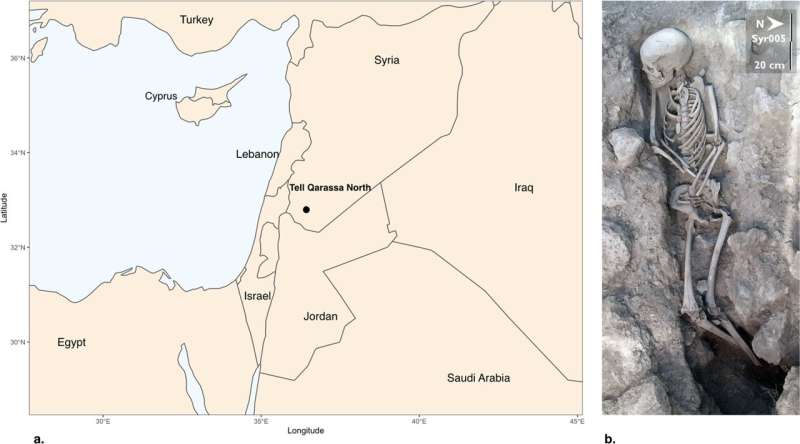Bioarchaeological evidence of very early Islamic burials in the Levant

A new study combining archaeological, historical and bioarchaeological data provides new insights into the early Islamic period in modern-day Syria. The research team was planning to focus on a much older time period but came across what they believe to be remains of early Muslims in the Syrian countryside. Their results were published in Communications Biology.
The Middle East is well known as a region with a rich and fascinating history embracing a wide range of ethnicities, cultures and religious practices. While a great part of this diverse and dynamic history is known through historical records, the impressive material culture and archaeological sites in the region, until recently important bioarcheological data was more difficult to retrieve due to the poor preservation of organic materials in harsh environments. New technologies that are more capable of analyzing degraded material, however, have changed this and stories from prehistoric to historic times have emerged, enriching our knowledge of this region at the crossroads between three continents. Now, a multinational and interdisciplinary team is presenting new bioarchaeological insights into the early Islamic period in modern-day Syria.
During 2009 and 2010, excavations at the Neolithic site of Tell Qarassa in modern-day Syria encountered a number of burials. These excavations were coordinated by a Spanish-French team integrating Syrian students in all archaeological campaigns, thereby contributing to their training in archaeology. The research was conducted with permission from and in constant coordination with the General Directorate of Antiquities and Museums (DGAM) of the Syrian Arab Republic. Shortly after these excavations, the Syrian civil war began, which continues to this day.
"With the goal of studying the first farming groups in the region, we subjected the remains of 14 humans to ancient DNA analysis," says archaeogeneticist Cristina Valdiosera of the University of Burgos, Spain, who coordinated the study. "Only two individuals from upper layers of the site contained sufficient amounts of endogenous DNA and these came from graves that we assumed belonged to a later prehistoric period. After radiocarbon dating it became clear we had something unexpected and special."
The graves dated to the Umayyad Era in the late 7th and early 8th centuries (the second caliphate). In light of these surprisingly recent dates, a reassessment of the burial style showed that it would be consistent with early Muslim burial practices. It would have been impossible to pinpoint this cultural identity without the radiocarbon dates as there were no previously known Muslim settlements or burial sites in the area and the archaeological site itself was only known as a prehistoric site.
"The genomic results were also surprising as the two individuals seemed genetically different from most ancient or modern-day Levantines. The most similar—though not identical—modern-day groups were Bedouins and Saudis, suggesting a possible connection to the Arabian Peninsula," says evolutionary biologist Megha Srigyan, who conducted the data analysis during her Master's studies at Uppsala University, Sweden.
"Most of our evidence is indirect but the different types of data, taken together, point to this man and woman belonging to transient groups far from home, suggesting the presence of early Muslims in the Syrian countryside," says population geneticist Torsten Günther at Uppsala University, who co-coordinated the study.
The analysis of one man and one woman provided evidence of new cultural/religious practices arriving in the Levant.
"It is extraordinary that by studying just two individuals, we were able to uncover a small but remarkable piece of the colossal puzzle that makes up the history of the Levant," says Cristina Valdiosera.
"In this particular case, there was no way we could have reached a conclusion without combining the archaeological, historical and bioarchaeological data, as each of these provided essential clues, highlighting the importance of a multidisciplinary approach," Torsten Günther concludes.
The human remains recovered in Qarassa, as well as the rest of the archaeological material, were deposited at the Archaeological Museum of Sweida (Syria) and, from that moment, they have been under the responsibility of the Syrian DGAM, as per their regulations.
More information: Megha Srigyan et al, Bioarchaeological evidence of one of the earliest Islamic burials in the Levant, Communications Biology (2022). DOI: 10.1038/s42003-022-03508-4
Journal information: Communications Biology
Provided by Uppsala University





















